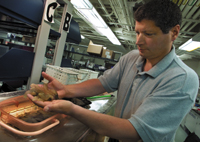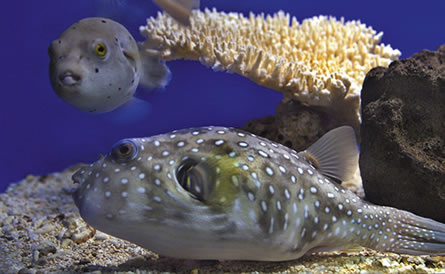|
In the spring of 2002, the Department of Energy's Joint
Genome Institute (JGI) completed the draft sequence of the
genome of Ciona intestinalis, a sea squirt. A few months
later JGI reported the first results of an analysis of the
genome of Fugu rubripes, a puffer fish, whose draft
sequence had been completed the preceding autumn. JGI also
announced it had begun sequencing the genome of the African
frog Xenopus tropicalis.
|
|
 |
|
| |
 |
| Paul Richardson, head of functional
genomics at JGI, holds a sea squirt. To gain insight into
the human genome, researchers are surveying many hundreds
of millions of years of evolutionary time, seeking clues
in our ancient relatives. |
|
| |
|
Why this odd array of organisms? (Not to mention other sequencing
projects, including a tree, a wood-eating fungus, the house
mouse, and a few dozen bacteria.) It all began with the Human
Genome Project, during which JGI sequenced chromosomes 5,
16, and 19. To accomplish this, JGI installed industrial-scale
sequencing machines that could determine the order of hundreds
of base pairs of DNA every second--a rate that continues to
increase.
Some of JGI's sequencing capacity is now zeroing in on useful
or dangerous organisms like microbes. But much effort is aimed
at a larger scientific question.
"The overall reason for genome work is to gain insight
into the function of the human genome," says Paul Richardson
of Berkeley Lab's Genomics Division, head of functional genomics
at JGI. "To see significant changes in the genes, especially
well conserved genes, you might have to go several hundred
million years back in time to a common ancestor, something
like Ciona."
Sea squirts stay put as adults, but as tadpoles they swim
freely, propelled by a tail stiffened by a kind of forerunner
of the backbone. Remarkably for so primitive an organism,
squirts possess hearts, nervous systems, immune systems, and
an analog of the thyroid gland.
If it's no surprise that many of our relatives' genes, even
relatives as distant as the sea squirt, are much like our
own and perform similar functions, it's a short step to the
hypothesis that other similar sequences may also be genes,
albeit with functions yet unknown. Indeed, the first payoff
of JGI's comparison of the human genome with that of the puffer
fish was the prediction of 961 previously unidentified human
genes. Knowing they're there is the first step to finding
out what they do.
According to Dan Rokhsar of Berkeley Lab's Physical Biosciences
Division, head of computational genomics at JGI, Fugu rubripes
was especially suited to this task because, odd as it seems
(a deadly Japanese delicacy, Fugu fatally poisons over a dozen
people a year), "almost three-quarters of human genes
find identifiable counterparts in Fugu." And the genes
are easier to find: Rokhsar notes that because it lacks much
of the noncoding DNA found in humans, the puffer's compact
genome is just one-eighth human-genome size.
There's more to comparative genomics than finding new genes.
The sea squirt and puffer fish genomes are expected to yield
significant knowledge of how genes are regulated and how they
interact within cells. Researchers look for very short sequences
of DNA that are the same in squirt, puffer, human, and other
organisms. Though often widely separated from genes, these
are likely to be the promoters, enhancers, and transcription
factors that signal genes when to turn on and off.
|
 |
| |
| Fugu Rubripes. The genome of
the Fugu fish contains essentially the same genes and
regulatory sequences as the human, but the genes are easier
to find, because Fugu lacks much of the noncoding or "junk
DNA" found in humans. Fugu's compact genome is just
one-eighth human-genome size. |
| |
Beyond comparative genomics lies functional genomics. Frog
researchers hope that when JGI completes the draft genome
of Xenopus tropicalis, the fast-breeding frog will
become the premier vertebrate model for functional genomics.
Many factors besides regulatory sequences are involved in
the functioning of genes, including the phenomenon of alternative
splicing, in which coding sequences in a single gene may rearrange
themselves to produce quite different proteins. Hardly rare,
a third or more of all human genes are estimated to have alternative
splices.
In the past, functional studies have been done one gene at
a time, but the massive Human Genome Project has inspired
a move toward studying the complex networks of relationships
by which genes conduct most of their business.
"As historic and important as the Human Genome Project
is," says Eddy Rubin of Berkeley Lab's Life Sciences
Division, interim director of JGI, "it's only the first
step in determining how genes work--and why they sometimes
don't work the way they should."
The Joint Genome Institute is jointly operated by Lawrence
Berkeley, Lawrence Livermore, and Los Alamos National Laboratories.
Sequencing of Fugu rubripes, Ciona intestinalis,
Xenopus tropicalis and other organisms is carried out
in concert with many other research groups.
-- Paul Preuss
|



